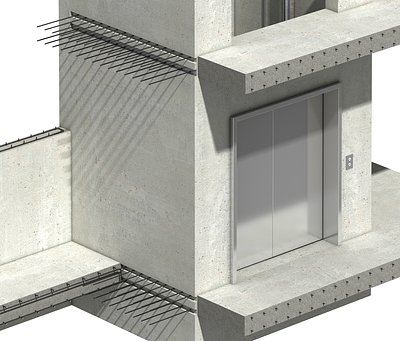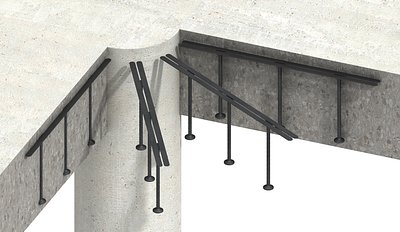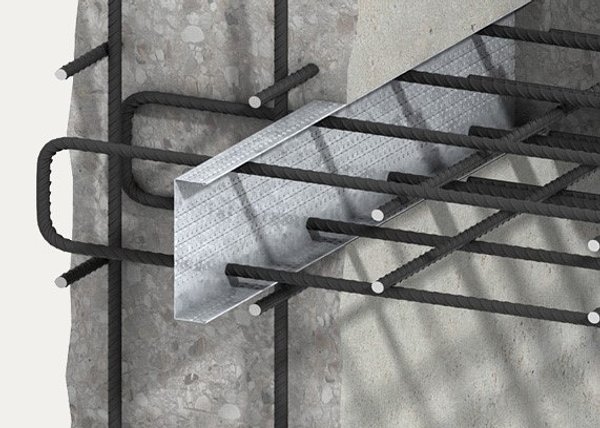Connections in construction: reinforced concrete frames
Concrete is the most commonly used construction material on earth. People have been using concrete to create pioneering buildings since Egyptian times. The Romans used it to create such enduring architectural wonders as the Pantheon in Rome.
The properties of concrete make it an extremely versatile building material, being plastic and malleable when freshly mixed, yet strong and durable once hardened. Reinforced concrete construction is used to build a huge variety of structures, from skyscrapers and roads to bridges and dams.
Holding concrete structures together securely, connecting joints between slabs and transferring loads throughout the structure is the job of steel rebar couplers, reinforcement continuity systems, stud rails and shear dowels. These essential yet hidden components play a vital role in any concrete structure, enabling architectural features to be achieved, reducing the weight of concrete required and improving the safety of both the construction process and the completed building.
Concrete Movement joints
To allow for movement in a finished building, concrete structures are designed with expansion and contraction joints between slabs. At these joints, steel dowels or keyed joints are used to transfer shear loads.

Ancon DSD Shear Load Connector
However, keyed joints require complicated formwork and if not formed correctly can cause cracking to take place in the concrete. Alternatively, single dowelled joints are effective at transferring shear but suffer from deformation which can result in subsequent spalling of the concrete. Single dowels also need to be accurately aligned in both directions to ensure movement can actually take place, otherwise cracking is likely to occur.
The innovative design of Ancon shear load connectors enables load to be transferred effectively while accommodating movement in the structure. Ancon DSD shear connectors have a two-part assembly, which makes them easier to install than plain dowels. Drilling of either formwork or concrete is also not required and the sleeve of Ancon shear dowels is simply nailed to the formwork ensuring subsequent alignment with the dowel, essential for effective movement.
Post-tensioned concrete construction
Post-tensioned concrete structures require temporary movement joints to allow for the initial shrinkage of the concrete. These joints traditionally take the form of metre-wide ‘pour strips’ between the slabs, which require the slabs to be temporarily propped from below until shrinkage has occurred and the pour strip filled with concrete.

Ancon Lockable Dowel
To provide a safer, simpler, solution, Ancon has developed lockable dowels. These remove the need for potentially hazardous wide pour strips and the associated complex support structures, which clutter the site. Instead, the dowels are inserted at the edge of concrete slabs, transferring load between the joints and allowing initial shrinkage to take place. The dowel is then locked in position with a mechanical plate and filled with epoxy resin. The locked dowel continues to transfer shear loads, but prevents any further movement.
Joining reinforcing bars
There are two methods of connecting reinforcing steel bars – lapped joints or the use of rebar couplers. The use of laps can be time consuming in terms of design and installation and can lead to greater congestion within the concrete because of the increased amount of rebar used. By comparison reinforcing bar couplers can help to simplify the design and construction of reinforced concrete structures, as well as reducing the amount of reinforcement required.

Tapered Thread Rebar Coupler
Reinforcement continuity at concrete joints

Where concrete slabs connect to walls, columns or floors, the reinforcement bars need to be connected securely so that reinforcement can be continued across the joint.
Ancon KSN Anchors are used in combination with Bartec parallel-threaded reinforcing bars, to simplify concrete construction joints. Together, they allow slab-to-wall connections to be designed with no restrictions on bar length and bar diameter.
Eazistrip Reinforcement Continuity Systems are also used to maintain reinforcement at construction joints. Pre-bent bars are housed within a galvanised steel casing, secured by a protective cover. When the cover is removed the bars can be straightened ready for lapping onto the main reinforcement.
Column reinforcement to prevent punching shear
Where a concrete slab is supported on a column, the weight of the slab creates considerable shear stresses. Without sufficient reinforcement, this could result in the column ‘punching’ through the slab.

Shearfix Stud Rail
One solution is to thicken the concrete slab above and below the columns, but this reduces headroom in the building and requires more concrete. A more efficient solution is to incorporate the Ancon Shearfix stud rail system within the slab reinforcement above and below the columns. This strengthens the reinforcement around slab-to-column connections, eliminating the problems associated with punching shear.
Related Products

Shear Load Connectors
Concrete structures are designed with expansion and contraction joints to allow movement to take place.

Reinforcing Bar Couplers
The use of Ancon Reinforcing Bar Couplers can simplify the design and construction of reinforced concrete and reduce the amount of reinforcement required.

Reinforcement Continuity Systems
Leviat manufactures six Ancon products which provide continuity of reinforcement at slab-to-wall construction joints in concrete.
Latest News
Leviat Introduces A1-Rated Non-combustible Insulation Retaining Clip for High-Rise Projects
Leviat, global leader in engineered construction solutions, has launched the Ancon A1-ST1 insulation retaining clip, a new non-combustible, A1-rated solution specifically designed to fit the Ancon ST1 heavy duty wall tie widely used in high-rise buildings.
Leviat Sponsors Concrete Society Awards 2025
Leviat is delighted to announce its continued sponsorship of the popular Concrete Society Awards for 2025, taking place on Wednesday 12th November, at London’s Royal Lancaster Hotel.


0 comments
Please leave a comment using the form below